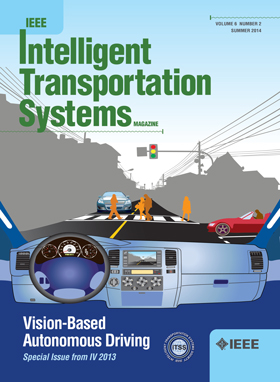Interactive Behavior Modeling for Vulnerable Road Users With Risk-Taking Styles in Urban Scenarios: A Heterogeneous Graph Learning Approach
IF 7.9
1区 工程技术
Q1 ENGINEERING, CIVIL
IEEE Transactions on Intelligent Transportation Systems
Pub Date : 2024-03-22
DOI:10.1109/TITS.2024.3399481
引用次数: 0
Abstract
The deep understanding of the behaviors of traffic participants is essential to guarantee the safety of automated vehicles (AV) in mixed traffic with vulnerable road users (VRUs). Precise trajectory prediction of traffic participants can provide reasonable solution space for motion planning of AV. Early works mainly focused on handcrafting the feature representation and designing complicated architectures in deep learning-based prediction models. However, these approaches overlooked the fact that different road users perceive the safety of the same interaction differently and also exhibit heterogeneous risk-taking styles. In this paper, we will develop a model for trajectory prediction based on risk-taking styles. The model accounts for the expected positions and occupancy of traffic participants in the surrounding environment. It consists of two sequential steps: risk-taking styles of multi-modal road users under interactive scenes are first clustered, and then reformulated in the heterogeneous graph model for trajectory prediction. The model is validated by the driving data collected on the urban road using a public dataset. Comparative experiments demonstrate that the proposed method can predict the trajectory of traffic participants much more accurately than the state-of-the-art methods.城市场景中具有冒险风格的弱势道路使用者的互动行为建模:异构图学习方法
要保证自动驾驶汽车(AV)在与易受伤害的道路使用者(VRU)混合交通中的安全,深入了解交通参与者的行为至关重要。对交通参与者的精确轨迹预测可以为自动驾驶汽车的运动规划提供合理的解决方案空间。早期的工作主要集中在手工制作特征表示和设计基于深度学习预测模型的复杂架构。然而,这些方法忽略了一个事实,即不同的道路使用者对同一交互行为的安全性有不同的感知,同时也表现出不同的风险承担风格。在本文中,我们将开发一种基于冒险风格的轨迹预测模型。该模型考虑了周围环境中交通参与者的预期位置和占用率。该模型包括两个连续步骤:首先对互动场景下多模式道路使用者的冒险风格进行聚类,然后在异构图模型中重新表述,以进行轨迹预测。该模型通过公共数据集收集的城市道路驾驶数据进行了验证。对比实验证明,与最先进的方法相比,所提出的方法能更准确地预测交通参与者的轨迹。
本文章由计算机程序翻译,如有差异,请以英文原文为准。
求助全文
约1分钟内获得全文
求助全文
来源期刊

IEEE Transactions on Intelligent Transportation Systems
工程技术-工程:电子与电气
CiteScore
14.80
自引率
12.90%
发文量
1872
审稿时长
7.5 months
期刊介绍:
The theoretical, experimental and operational aspects of electrical and electronics engineering and information technologies as applied to Intelligent Transportation Systems (ITS). Intelligent Transportation Systems are defined as those systems utilizing synergistic technologies and systems engineering concepts to develop and improve transportation systems of all kinds. The scope of this interdisciplinary activity includes the promotion, consolidation and coordination of ITS technical activities among IEEE entities, and providing a focus for cooperative activities, both internally and externally.
 求助内容:
求助内容: 应助结果提醒方式:
应助结果提醒方式:


